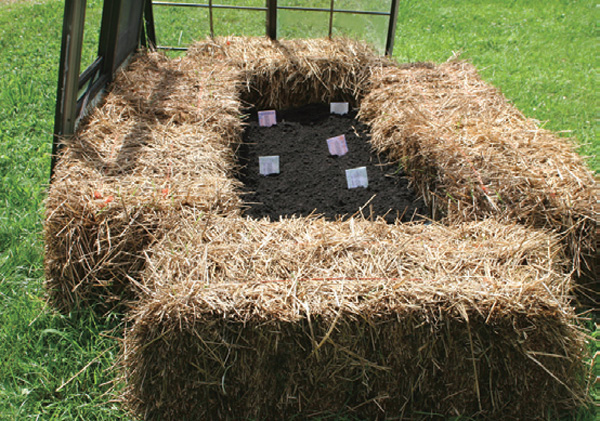
In the 2009 NGJ calendar page for December, there are instructions on how to build a simple mini-greenhouse suitable for growing greens in the cold months or as a place to start your seeds in late winter or early spring. If you are like me—no tools and no ability as a builder?have no fear: you can make a simple mini-greenhouse with straw bales and old windows or doors. Why pay high prices for organic fresh greens? This is so simple, anyone can do it, and you can do it anywhere!
Find a south-facing sunny spot outside, take 4-6 straw bales and arrange them on the ground (yes, on top of the grass) in a rectangle—the two long sides are made with two bales, end to end, and the two short ends have one bale each. The thick straw walls provide excellent insulation. Spread out a few layers of newspaper or brown paper bags (I used old maps) on the ground inside your rectangle. Fill the rectangle half-full with good soil from your compost pile or potting soil from a garden center.
Plant cold-hardy seeds or young plants in the soil and lay the windows on top of the bales. You can keep a thermometer inside the mini-greenhouse to watch the temperature. If it gets too hot (above 80 degrees), prop up one side of the window or slide it off to let the hot air escape. I keep clear plastic on top of the glass to cut down on the amount of intense sun that sometimes comes with sunny winter days. If the plants get too hot, it will burn them up. If it gets too cold at night, just cover the glass with an old quilt or blanket to keep the warmth inside.
The best kind of plants are lettuce, spinach, kale, collards, turnip greens, beet greens, Swiss chard, green onions, cilantro, parsley, dandelions, etc. Some people have been successful extending the growing season of warm-weather plants, like cucumbers or tomatoes, by covering them just before frost.
An alternative to growing food in the mini-greenhouse is making it a “hothouse” for starting your spring garden. You can add additional warmth to your little hothouse by first placing green manure several inches deep on the ground, then add the compost and potting soil inside your little greenhouse. Place seeds in starting flats or directly into the soil. The decomposing manure gives off heat that keeps the greenhouse temperature “hot” even on cold nights. The composting manure will provide heat for about two weeks, but the rotting straw will continue to provide some heat.
The straw bale mini-greenhouse can be used in very cold climates as long as care is taken to keep snow off the glass in the day and to place a blanket over the glass at night to keep it warm. The straw will decompose slowly and can be used for mulch on your spring garden. Get started now to give your plants a couple of months of growing time and enjoy delicious, home-grown vegetables right from your own garden!
You must be logged in to post a comment.
Thanks for the article - we have cold weather most of the year - which makes it much more expensive to eat healthy - I look forward to giving this a try!
WONDERFUL article! Never thought of this idea! Another "winter" thought is do sprouts indoors!
Cindy
http://www.grainlady.com